You can run a plasma cutter on nitrogen, and in many cases you should. Nitrogen’s inert profile limits oxidation on stainless and aluminum, improves edge quality, and supports faster speeds in higher-amperage systems. It also extends consumable life when paired with proper swirl rings and torch parameters. But it’s not universal—gas choice depends on material, thickness, and finish standards. If you’re balancing cost, cut quality, and shop setup, the trade-offs get interesting.
How Plasma Cutting Works
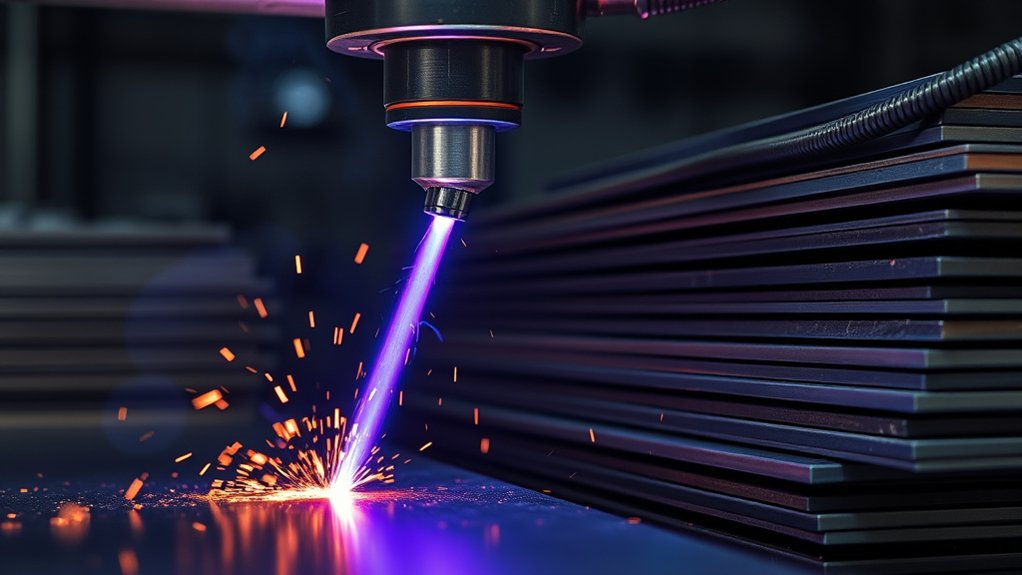
Initiate a plasma cut by striking an electric arc through a high-velocity gas stream, heating the gas into an ionized plasma that conducts electricity and transfers energy directly to the workpiece.
You control arc stability and heat density by matching current, gas flow, and standoff to the material and thickness. In plasma cutting, the constricted jet from plasma torches accelerates the arc, ejects molten metal, and maintains a kerf with minimal bevel when parameters are within spec.
Use gas selection to manage edge quality and oxidation. Nitrogen supports a clean cut by limiting atmospheric contamination at the arc column, especially when cutting aluminum and stainless steel, where oxide control and mechanical properties matter.
Use gas selection to control edges and oxidation; nitrogen excels on aluminum and stainless for cleaner cuts.
The shielding effect reduces dross and preserves dimensional tolerance. Maintain torch alignment, consumable integrity, and consistent travel speed to keep arc attachment stable and prevent double-arcing.
Verify gas purity and flow rates; inadequate shielding elevates porosity risks and roughness, undermining process repeatability.
Common Gases Used in Plasma Cutting

As you select a plasma gas, standard options include compressed air, nitrogen, oxygen, and argon‑based mixes, each aligned to specific torch ratings and cut specs.
You’ll match gases to materials—nitrogen or argon‑mixes for stainless and aluminum to limit oxidation and dross, oxygen for mild steel speed, and air for general-purpose cuts.
You must balance cost and performance: nitrogen and mixes deliver cleaner edges and higher speed but at higher operating cost than air.
Primary Plasma Gas Options
Choosing the primary plasma gas sets your cut quality, speed, and operating cost baseline. When evaluating primary plasma gas options, specify outcomes by material, current range, and duty cycle.
Nitrogen for plasma cutting excels when cutting aluminum and stainless, limiting atmospheric contamination and delivering superior cut quality and speed with reduced dross and cleaner edges. It’s effective on high‑current systems and supports thicknesses up to about 3 inches.
For cost control on common materials, consider using compressed air; it’s a versatile plasma gas, but oxidation can increase cleanup and reduce edge precision.
You can blend nitrogen with CO2 or air to stabilize the arc and boost performance on thicker sections. Match gas purity, flow rate, and pressure to OEM specifications for repeatable results.
Material-Specific Gas Choices
Whether you’re targeting cut quality, speed, or cost, select plasma gases by base metal, thickness, and current range, then validate to OEM flow/pressure specs. Match gas chemistry to objectives: use nitrogen when plasma cutting aluminum and stainless where an inert gas minimizes oxidation and dross formation. Nitrogen delivers high cut quality, tight kerf, and extended consumable life, especially on thicker sections. For carbon steel, compressed air is acceptable but may raise dross and edge tint. Blend nitrogen with secondary gases (air or CO2) to stabilize the arc and refine edges.
| Material/Thickness | Recommended Gas Setup |
|---|---|
| Aluminum ≤12 mm | Nitrogen (inert gas) |
| Aluminum >12 mm | Nitrogen + secondary gases |
| Stainless ≤25 mm | Nitrogen |
| Stainless >25 mm | Nitrogen + secondary gases |
| Carbon steel (general) | Compressed air (monitor cut quality) |
Configure swirl, flow, and pressure to spec to minimize rework.
Cost and Performance Tradeoffs
Although multiple gases can produce acceptable cuts, each option carries distinct cost and performance implications you should weigh against job requirements and OEM specs.
Nitrogen typically delivers cleaner cuts, higher cutting speed, and superior edge quality on stainless and aluminum by limiting oxidation on the cut surface. However, you’ll accept higher operational costs for bottled gas, regulators, and flow controls.
Compressed air is economical and versatile up to about 1 inch, eliminating gas purchases and simplifying logistics, but it can increase oxide formation and post-processing on sensitive alloys.
To optimize nitrogen, follow OEM regulator settings, verify flow, and maintain dry, oil-free supply to limit consumable wear.
Validate performance with cut coupons, measuring speed, kerf, dross, and edge roughness.
Balance gas cost against throughput, rework, and tip life.
When to Choose Nitrogen
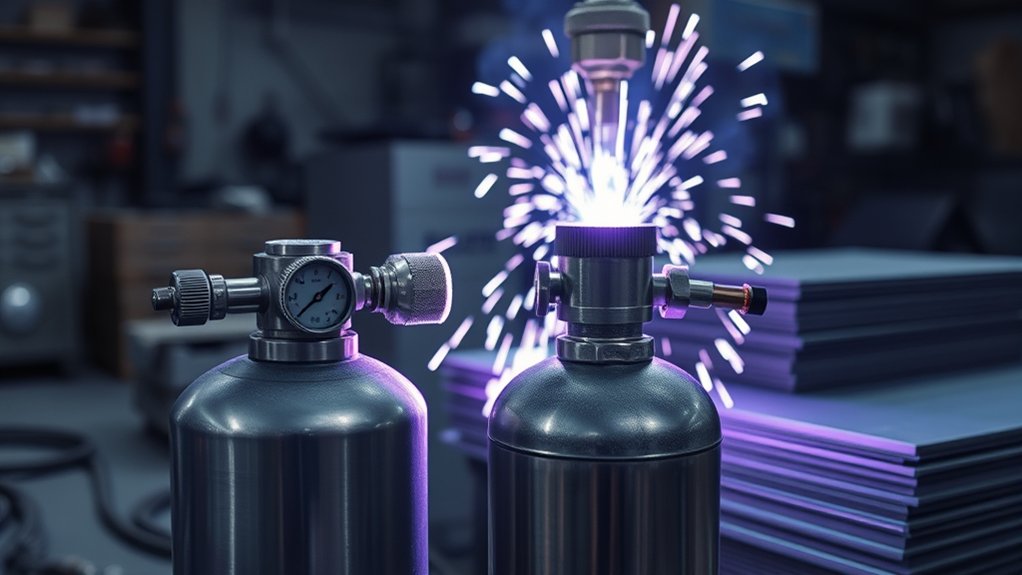
Choose nitrogen when you’re cutting stainless steel or aluminum, especially at higher currents and thicknesses up to about 3 inches, to minimize oxidation and dross.
You’ll get cleaner edges and faster speeds than compressed air, supporting tighter tolerances and extended consumable life.
Balance this against higher gas costs by specifying nitrogen for production runs or thicker sections where cut quality and throughput justify the expense.
Best Materials/Thicknesses
When cut quality and corrosion resistance drive your spec, select nitrogen for stainless steel and aluminum, especially on precision profiles.
Use nitrogen cutting on stainless steel from thin gauge to heavy plate; a modern plasma cutter can maintain clean, low-oxidation edges up to about 3 inches thickness.
For aluminum, nitrogen improves edge fidelity and supports higher traverse speeds than compressed air, ideal for burr-minimized contours and tight tolerances.
Specify nitrogen when you must reduce dross and heat tint, or when downstream finishing must be minimized.
It also extends consumable life—expect well over 1,000 starts with correct parameters—supporting consistent performance.
Balance the superior cut quality and process stability against higher operational costs, applying nitrogen where dimensional accuracy and surface integrity are critical.
Cost and Cut Quality
Optimization turns on a simple trade-off: nitrogen raises cut quality and speed on stainless and aluminum but increases operating cost versus compressed air.
Choose nitrogen when the specification prioritizes clean cut quality, minimal dross formation, and high precision on nonferrous alloys. Its inert behavior suppresses oxidation, sharpens edge definition, and supports higher traverse rates.
Although nitrogen elevates operational costs, it offsets some expense by extending consumable life; electrodes and nozzles commonly exceed 1,000 starts, stabilizing process capability in production.
For cost-sensitive work or mild steel cutting where oxide edges are acceptable, compressed air remains practical.
Validate with test coupons: compare kerf angle, HAZ width, dross removal time, and cut speed. Use total cost per part—gas, consumables, secondary cleanup—to decide when nitrogen delivers net value.
Nitrogen vs. Compressed Air
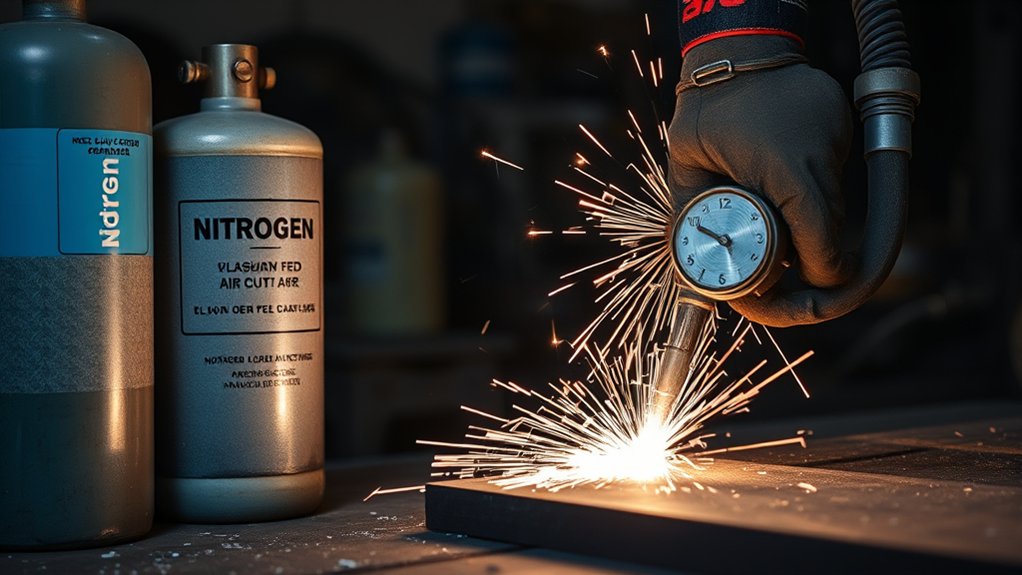
Although both gases can power a plasma torch effectively, nitrogen and compressed air differ in cut quality, speed, cost, and maintenance requirements. As your primary plasma gas, nitrogen optimizes cutting quality and cut edge on stainless steel and aluminum by limiting oxidation; compressed air remains versatile and economical for mild steel while still acceptable on stainless. Expect nitrogen to run faster with cleaner edges, but higher operational costs and stricter gas handling apply. Compressed air simplifies supply and supports thicknesses up to 1 inch across materials.
- Use nitrogen when precision on stainless steel or aluminum is critical.
- Use compressed air when cost control and broad applicability on mild steel dominate.
| Factor | Practical Guidance |
|---|---|
| Cut edge | Nitrogen: cleaner on stainless; Air: satisfactory on mild steel |
| Speed | Nitrogen generally faster; Air adequate for general work |
| Cost/Maintenance | Nitrogen: higher operational costs, tighter upkeep; Air: lowest cost, simpler care |
Follow manufacturer parameters for gas pressure, flow, and nozzle selection.
Nitrogen vs. Oxygen for Different Metals

Even if your machine can run multiple gases, match nitrogen or oxygen to the metal to control oxidation, edge quality, speed, and consumable wear. In plasma cutting, select gases by material behavior and process standards.
Use oxygen on mild steel to maximize cutting speeds and cut quality; the exothermic reaction ejects molten metal efficiently, minimizing dross. Don’t apply oxygen to stainless steel or aluminum—oxidation degrades edges and accelerates consumable wear.
Choose nitrogen for stainless steel and aluminum. Its inert nature limits atmospheric contamination, stabilizes the arc, and produces cleaner kerfs.
On stainless steel, nitrogen improves cut quality and extends nozzle and electrode life. On aluminum, nitrogen delivers smoother edges and higher cutting speeds than oxygen, avoiding roughness from oxide formation.
While nitrogen can carry higher operating cost than compressed air, its material-specific advantages justify use where specifications prioritize surface integrity, precision tolerances, and predictable post-cut finishing with minimal rework.
Argon-Hydrogen and Other Gas Mixes

For thick-plate cutting, you’ll often specify the H-35 mix (65% Ar / 35% H2) to maximize energy density, stabilize the arc, and produce smooth surfaces with controlled dross.
You should pair it with appropriate shield gas options—argon, nitrogen, or nitrogen-secondary—per OEM parameters to optimize arc constriction and edge quality.
When you prioritize thick-plate performance, follow cut charts for amperage, gas flow, and standoff to balance cut speed, kerf, and cost versus conventional air or nitrogen.
H-35 Mix Benefits
Two gases, precisely blended as H-35 (65% argon, 35% hydrogen), deliver the hottest plasma jet for cutting thick nonferrous and stainless materials.
With the H-35 mixture, you increase cutting capability on thick stainless steel and aluminum over 1/2 inch while maintaining high-quality cuts. The hydrogen boosts enthalpy and jet velocity; argon stabilizes the plasma column, yielding straight kerfs and minimal dross. You’ll achieve polished surfaces that meet tight tolerance and finish requirements.
Use nitrogen as a compatible shield gas when you need to control surface chemistry; it reduces oxidation and preserves edge color on high-alloy steels.
Expect consistent arc stability, reduced secondary finishing, and improved throughput. Although H-35 costs more than standard gases, its efficiency and cut quality justify deployment in high-performance workflows.
Shield Gas Options
While plasma gas selection drives arc energy, your shield gas choice controls surface chemistry, edge color, and dross formation on stainless and aluminum. For high-spec results, align the shield gas to material and current. An argon-hydrogen mixture (≈65% Ar / 35% H2) delivers smooth surfaces on stainless steel and aluminum; pair it with nitrogen as the shield gas to stabilize the arc, limit oxidation, and improve cutting quality.
On higher-current plasma systems, nitrogen shield gas is often preferred. It tightens the jet, promotes clean kerfs, and minimizes dross formation when matched to proper plasma gases. Verify torch and consumable compatibility.
Where supported, nitrogen-water shield concepts further suppress fumes and enhance finish. Maintain gas purity, correct flow, and nozzle stand-off per manufacturer specifications to guarantee consistent results.
Thick-Plate Performance
When you move from tuning shield gases to cutting heavy sections, gas selection shifts toward arc energy density and heat input control.
For thick stainless and aluminum over 1/2 inch, you’ll specify argon-hydrogen (65/35) on high-duty plasma cutters to drive deeper penetration and stable arcs. This mix yields clean cuts, straight kerfs, and smooth faces up to 4 inches (≤100 mm), with productivity that justifies the higher gas cost.
To control contamination and enhance cut quality, pair argon-hydrogen with nitrogen as a shield. The nitrogen curtain limits atmospheric ingress and helps maintain edge integrity.
Expect occasional jagged dross at the bottom edge; mitigate with correct standoff, amperage, and travel speed. Validate settings per procedure, document parameters, and verify results against cut-quality acceptance criteria.
Equipment Setup for Nitrogen Plasma
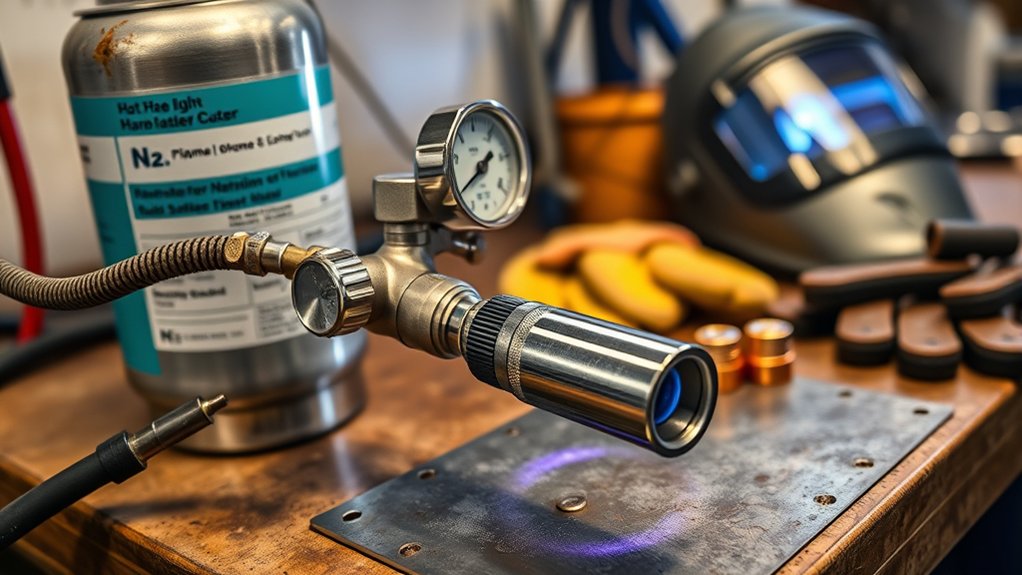
Start with a stable nitrogen supply and verified delivery capacity. Choose a reliable nitrogen supply—high-capacity bottles or a nitrogen generator—to maintain consistent flow through the cut.
Start with a stable nitrogen supply and verified delivery capacity for consistent, clean cutting performance.
Fit a regulator rated for nitrogen service and set ideal settings near 100 psi under load; validate pressure at the torch while cutting. Confirm adequate airflow (CFM) from the compressor or generator to sustain nozzle cooling and prevent thermal stress.
Where applicable, meter in secondary gases such as clean, dry air or CO2 to improve cutting quality and reduce dross formation. Document maintenance and checks for hoses, fittings, and filters to eliminate leaks and flow restrictions.
- Verify source purity, pressure rating, and flow charts match torch and OEM specs.
- Calibrate the regulator under load; log pressure stability across duty cycles.
- Measure delivered CFM at the machine inlet; compare to nozzle requirements.
- Integrate approved secondary gases with proper mixers and safety valves.
- Perform leak tests, filter changes, and hose inspections on a set interval.
Cut Quality, Speed, and Consumable Life
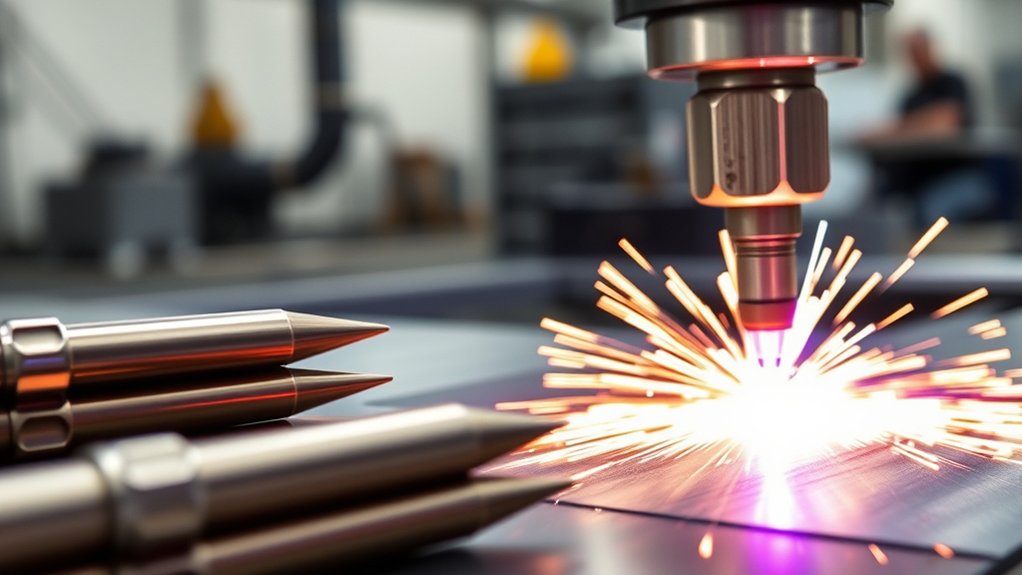
Precision hinges on gas choice: nitrogen plasma delivers cleaner edges and smoother kerfs than compressed air, especially on stainless and aluminum, with markedly less aluminum oxide.
You’ll see measurable gains in cut quality when you align gas selection with material and amperage. For stainless steel and aluminum, nitrogen plasma stabilizes the arc, reduces dross, and minimizes post-process finishing.
Expect higher speed on these alloys as well. With correct current, standoff, and flow calibration, nitrogen plasma sustains tighter kerfs and maintains edge squareness at increased traverse rates.
If you need additional refinement, use air as a secondary gas; the nitrogen/air pair often boosts speed while preserving a crisp edge profile.
Consumable life improves, too. Electrodes and nozzles routinely exceed 1,000 starts with nitrogen, reducing changeovers and variance.
Balance this with operational costs: nitrogen raises gas expense versus compressed air. Validate your process by tracking edge roughness, bevel angle, burr height, and starts-per-set to optimize consumable life and throughput.
Safety Tips for Aluminum and Water Tables

Although aluminum cuts cleanly on a water table, you must control hydrogen generation and heat to prevent hazardous conditions. Treat the process as a controlled operation: stage the aluminum sheet, verify ventilation, and set monitoring steps before you start cutting.
Hydrogen buildup can occur quickly, then continue after the arc stops, so establish a routine to vent and cool the table.
- Wear safety gear—goggles, face shield, gloves, sleeves—before energizing the plasma cutter.
- Load the aluminum sheet, then cut immediately to minimize dissolved hydrogen dwell time in the water table.
- “Burp” the water table with a brief torch pass at the perimeter to release trapped gas and equalize pressure.
- Monitor for boiling, unusual bubbling, or heat soak; pause cutting and vent if temperature rises or agitation increases.
- Perform regular maintenance: skim debris, check water chemistry and level, clean slats, and verify pumps/vents to sustain cooling and reduce gas accumulation.
Document procedures and train operators to guarantee repeatable safety.
Cost and Productivity Considerations

When you choose between nitrogen and compressed air for plasma cutting, evaluate cost per cut alongside throughput, edge quality, and rework risk. Nitrogen improves cut quality on stainless and aluminum, reduces oxidation and dross formation, and may raise productivity on tight-tolerance work. However, its operational costs and initial investment in gas supply and equipment are higher. Compressed air is economical and sufficient when quality requirements are moderate and metal thickness is lower.
- For thin to moderate metal thickness, compressed air often meets takt time with acceptable finish.
- For premium finishes or faster speeds on stainless/aluminum, nitrogen can offset rework and post-processing.
| Factor | Guidance |
|---|---|
| Gas choice | Match to cut quality and finish specs |
| Operational costs | Include gas, consumables, maintenance |
| Productivity | Compare feed rate, pierce time, rework load |
| Metal thickness | Thicker sections may favor nitrogen stability |
| Dross formation | Quantify removal time in cost-per-cut model |
Run trials, log metrics, and calculate ROI before committing.
Frequently Asked Questions
Do Plasma Cutters Use Nitrogen?
Yes, you can use nitrogen in plasma cutting technology. You’ll select gas types based on material and industrial applications. Nitrogen benefits include improved cutter efficiency, plasma arc stability, cleaner edges; weigh cost comparison, implement safety measures, and follow standards.
What Kind of Gas Do Plasma Cutters Use?
Plasma cutters use compressed air, oxygen, nitrogen, and argon-hydrogen. Like gears meshing, you match gas types comparison to the plasma cutting process: consider nitrogen properties, cutting thickness impact, arc stability factors, gas flow rates, cost analysis, and safety considerations.
Why Use Nitrogen Instead of Compressed Air?
You choose nitrogen for superior cutting quality and plasma cutting advantages: cleaner edges, less dross, better gas efficiency, and longer consumable life. Despite cost comparison drawbacks, it meets industry standards, enhances equipment compatibility, improves stainless/aluminum performance, and supports critical safety considerations.
Can You Plasma Cut Without Gas?
No—you can’t plasma cut without gas. Picture lightning needing air. You evaluate plasma cutting techniques, gas alternatives, cutter efficiency, metal thickness, safety precautions, cost comparison, equipment maintenance, and user experience to meet standards, stabilize arcs, cool consumables, and guarantee repeatable quality.
Conclusion
You can confidently specify nitrogen for plasma cutting when edge integrity and speed matter. In stainless and aluminum, you’ll reduce oxidation and tighten tolerances, often boosting throughput by 10–20% versus shop air. Validate with cut charts, correct swirl ring, nozzle, and standoff, then document amperage, gas flow, and duty cycle per OEM specs. Monitor kerf angle and dross to adjust parameters. You’ll also extend consumable life, lowering downtime and stabilizing process capability for repeatable, standards-compliant results.



